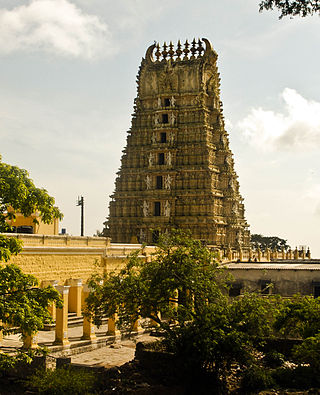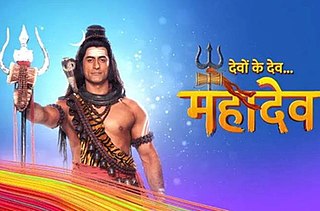
Parvati, also known as Uma and Gauri, is the Hindu goddess of power, energy, nourishment, harmony, love, beauty, devotion, and motherhood. In her complete form, she is a physical representation of Mahadevi also known as Adi Shakti, the primordial power behind the creation of the universe, the creator and destroyer. She is one of the central deities of the goddess-oriented sect called Shaktism, and the supreme goddess in Shaivism. Along with Lakshmi and Sarasvati, she forms the Tridevi.

Ardhanarishvara, is a form of the Hindu deity Shiva combined with his consort Parvati. Ardhanarishvara is depicted as half-male and half-female, equally split down the middle. The right half is usually the male Shiva, illustrating his traditional attributes.

The Vishalakshi Temple or Vishalakshi Gauri Temple is a Hindu temple dedicated to the goddess Vishalakshi, at Mir Ghat on the banks of the Ganges at Varanasi in Uttar Pradesh, India. It is generally regarded as a Shakti Pitha, the most sacred temples dedicated to the Hindu Divine Mother.

The Chamundeshwari Temple is a Hindu temple located on the top of Chamundi Hills about 13 km from the palace city of Mysuru in the state of Karnataka in India. The temple was named after Chamundeshwari or, the fierce form of Shakti, a tutelary deity held in reverence for centuries by the Maharaja of Mysuru.

Kali or Kalika is a major Hindu goddess associated with time, change, creation, power, destruction and death in Shaktism. Kali is the first of the ten Mahavidyas in the Hindu tantric tradition.

Devī is the Sanskrit word for 'goddess'; the masculine form is deva. Devi and deva mean 'heavenly, divine, anything of excellence', and are also gender-specific terms for a deity in Hinduism.

Ghanta is the Sanskrit term for a ritual bell used in Hindu religious practices. The ringing of the bell produces what is regarded as an auspicious sound. Hindu temples generally have one metal bell hanging at the entrance and devotees ring the bell while entering the temple which is an essential part in preparation of having a darshan. A bell is also rung by poojari during Pūjā or Yajna – during the waving of light, burning of incense in front of the deity, while bathing the deity and while offering food or flowers. There are bells specially made to produce the long strains of the sound Aum.

Kalaratri is the seventh of the nine Navadurga forms of the goddess Mahadevi. She is first referenced in the Devi Mahatmya. Kalaratri is one of the fearsome forms of the goddess.

Devon Ke Dev... Mahadev, often abbreviated as DKDM, is a series based on Shiva, one of the main deities of Hinduism, also known as Mahadev. It premiered on 18 December 2011, airing Monday to Friday nights on Life OK. The 820-episode series concluded on 14 December 2014. The entire series has been made available on Disney+ Hotstar and Hulu.

Nainativu Nagapooshani Amman Temple [Tamil: நயினாதீவு நாகபூசணி அம்மன் கோயில், romanized: Nayiṉātīvu Nākapūcaṇi Am'maṉ Kōyil - Meaning: Nainativu ; Nagapooshani ; Amman (Goddess)] is an ancient and historic Hindu temple located amidst the Palk Strait on the island of Nainativu, Sri Lanka. It is dedicated to Parvati who is known as Nagapooshani or Bhuvaneswari and her consort, Shiva who is named here as Nayinaar. The temple seems to have been mentioned in the Brahmanda Purana. The temple complex houses four gopurams ranging from 20–25 feet in height, to the tallest being the eastern Raja Raja Gopuram soaring at 108 feet high. The temple is a significant symbol for the Tamil people, and has been mentioned since antiquity in Tamil literature, such as Manimekalai and Kundalakesi. The present structure was built during 1720 to 1790 after the ancient structure was destroyed by the Portuguese in 1620. The temple attracts around 1000 visitors a day, and approximately 5000 visitors during festivals. The annual 16-day Mahostavam (Thiruvizha) festival celebrated during the Tamil month of Aani (June/July) - attracts over 100,000 pilgrims. There is an estimated 10,000 sculptures in this newly renovated temple.
Shailaputri (शैलपुत्री), is the daughter of the Mountain King Himavat, and is a manifestation and form of the Hindu mother goddess Mahadevi, representing herself as the pure form of goddess Parvati. She is the first Navadurga venerated during the first day of Navratri, and is a reincarnation of Goddess Sati.

Mahagauri is the eighth form among the Navadurga aspects of the Hindu mother goddess Mahadevi. She is worshipped on the eighth day of Navaratri. According to Hinduism, Mahagauri has the power to fulfill all the desires of her devotees.

Brahmacharini means a devoted female student who lives in an Ashrama with her Guru along with other students. She is the second aspect of the Navadurga forms of Mahadevi and is worshipped on the second day of Navaratri. The goddess Brahmacharini is an aspect of Parvati and wears white clothes, holding a japamala in her right hand and a kamandalu in her left.

Kushmanda is a Hindu goddess, credited with creating the world with her divine smile. Followers of the Kalikula tradition believe her to be the fourth aspect in Navadurga forms of Mahadevi. Her name signals her main role: Ku means "a little", Ushma means "warmth" or "energy" and Anda means "cosmic egg".

Jai Malhar is an Indian Marathi language mythological TV series which aired on Zee Marathi. It is based on the legend of the Hindu god Khandoba, an avatar (incarnation) of Shiva. It premiered from 18 May 2014 by replacing Tu Tithe Me. It starred Devdatta Nage, Surabhi Hande and Isha Keskar in lead roles.

Mahakaali — Anth Hi Aarambh Hai is an Indian television series that premiered on 22 July 2017 on Colors TV. The show traced the epic story of Goddess Parvati’s metamorphosis into Mahakali. Produced by Siddharth Kumar Tewary's Swastik Productions, it starred Pooja Sharma in the title role of Goddess Mahakali, Sourabh Raj Jain as Lord Mahadev and Kanan Malhotra as Lord Vishnu.

Jag Janani Maa Vaishno Devi – Kahani Mata Rani Ki, is an Indian mythological television series, which premiered on 30 September 2019 on Star Bharat. It is based on the life of Goddess Vaishno Devi. The series is produced by Rashmi Sharma and Pawan Kumar Marut under Rashmi Sharma Telefilms. The show aired its last episode on 2 October 2020.
Devi Adi Parashakti is a mythological television series based on the Hindu texts of the Shiva Purana, the Devi-Bhagavata Purana, the Markandeya Purana, and pan-Indian folktales of the Goddess. The series was created by Siddharth Kumar Tewary, directed by Loknath Pandey and Manish Singh, and produced by Swastik Productions. Rati Pandey plays the role of Devi Adi Parashakti and her incarnations Goddess Sati, and Goddess Parvati. Tarun Khanna played the role of Devi's husband, Lord Shiva with Kanan Malhotra as Lord Vishnu, Devi's brother. The show also features Sonia Singh as Goddess Diti, the main antagonist.

Mayana Kollai is a festival celebrated after Shivarathri on the first full moon day of February at the Angala Parameswari temples in Tamil Nadu, India. It is widely celebrated as Angala Parameswari Amman is the deity worshiped by the followers of Goddess Shakti in the form of Goddess MahaKali.Shakthi, The formless goddess associated with creation itself was reborn as Parvati. This was when Sandobi and Sundaran, two demons terrorized the gods and men. Brahma, The Creator god performed yagna for protection against the demons. Out of this yagna Tilottam, an apsara appeared. Attracted by her beauty the demons and Brahma started following her. She consequently seeked refuge in kailash abode of Lord Shiva, Where brahma followed her. Brahma, like Shiva had five heads. This was the reason why parvati mistook him to be her husband and fell at his feet in an act of submission †. Angered by this Shiva in the form of rudra beheaded the fifth head of Brahma and thus invoked a curse upon himself; The curse enabled the head to remain attached to his right hand and did not allow him to eat. The head (Kabala) was consuming all the available food instead of shiva himself. He became a mendicant and roamed earth begging and for food, sleeping in graveyards.



















